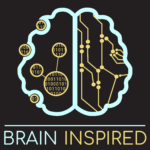
Support the show to get full episodes, full archive, and join the Discord community.

The Transmitter is an online publication that aims to deliver useful information, insights and tools to build bridges across neuroscience and advance research. Visit thetransmitter.org to explore the latest neuroscience news and perspectives, written by journalists and scientists.
Read more about our partnership.
Sign up for the “Brain Inspired” email alerts to be notified every time a new “Brain Inspired” episode is released.
To explore more neuroscience news and perspectives, visit thetransmitter.org.
Aran Nayebi is an Assistant Professor at Carnegie Mellon University in the Machine Learning Department. He was there in the early days of using convolutional neural networks to explain how our brains perform object recognition, and since then he’s a had a whirlwind trajectory through different AI architectures and algorithms and how they relate to biological architectures and algorithms, so we touch on some of what he has studied in that regard. But he also recently started his own lab, at CMU, and he has plans to integrate much of what he has learned to eventually develop autonomous agents that perform the tasks we want them to perform in similar at least ways that our brains perform them. So we discuss his ongoing plans to reverse-engineer our intelligence to build useful cognitive architectures of that sort.
We also discuss Aran’s suggestion that, at least in the NeuroAI world, the Turing test needs to be updated to include some measure of similarity of the internal representations used to achieve the various tasks the models perform. By internal representations, as we discuss, he means the population-level activity in the neural networks, not the mental representations philosophy of mind often refers to, or other philosophical notions of the term representation.
- Aran’s Website.
- Twitter: @ayan_nayebi.
- Related papers
0:00 – Intro
5:24 – Background
20:46 – Building embodied agents
33:00 – Adaptability
49:25 – Marr’s levels
54:12 – Sensorimotor loop and intrinsic goals
1:00:05 – NeuroAI Turing Test
1:18:18 – Representations
1:28:18 – How to know what to measure
1:32:56 – AI safety